
The Lecanoraceae are a family of lichenized fungi in the order Lecanorales. Species of this family have a widespread distribution.

Verrucariaceae is a family of lichens and a few non-lichenised fungi in the order Verrucariales. The lichens have a wide variety of thallus forms, from crustose (crust-like) to foliose (bushy) and squamulose (scaly). Most of them grow on land, some in freshwater and a few in the sea. Many are free-living but there are some species that are parasites on other lichens, while one marine species always lives together with a leafy green alga.

Porina is a genus of lichens in the family Trichotheliaceae. A 2020 estimate places about 145 species in the widespread genus.
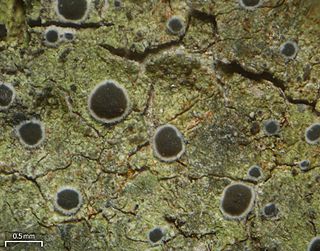
Byssoloma is a genus of leaf-dwelling lichens in the family Pilocarpaceae.
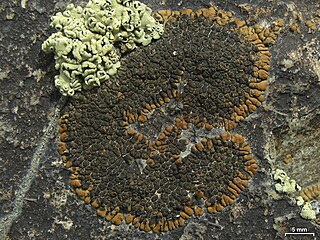
Sphaerellothecium is a genus of fungi in the family Phyllachoraceae. All of the species in the genus are lichenicolous, meaning they grow parasitically on lichens.

Endocarpon is a genus of saxicolous (rock-dwelling), crustose lichens in the family Verrucariaceae. The genus was circumscribed by German bryologist Johann Hedwig in 1789.
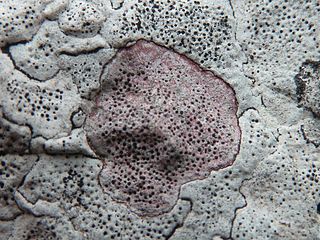
Bagliettoa is a genus of lichen-forming fungi in the family Verrucariaceae. The genus was circumscribed by Italian lichenologist Abramo Bartolommeo Massalongo in 1853. Bagliettoa species are endolithic, growing between the grains of solid rock.
Agonimia is a genus of lichen-forming fungi in the family Verrucariaceae.
Involucropyrenium is a genus of lichens in the family Verrucariaceae. It has nine species. The genus was circumscribed by Austrian lichenologist Othmar Breuss in 1996, with Involucropyrenium waltheri assigned as the type species.

Heteroplacidium is a genus of lichen-forming fungi in the family Verrucariaceae. The genus was circumscribed by Austrian lichenologist Othmar Breuss in 1996 with Heteroplacidium imbricatum assigned as the type species. It was proposed as a segregate of Catapyrenium. Other morphologically similar genera are Neocatapyrenium, Placidium, and Scleropyrenium, although molecular phylogenetic analyses indicate that they are independent monophyletic lineages within the Verrucariaceae.
Placopyrenium is a genus of lichens in the family Verrucariaceae. The genus was circumscribed in 1987 by Austrian lichenologist Othmar Breuss.
Endococcus is a genus of lichenicolous (lichen-dwelling) in the family Lichenotheliaceae. It has 44 species. The genus was circumscribed by the Finnish botanist William Nylander in 1855. Although at least one source places the genus in the Verrucariaceae, a 2016 study of the type species, Endococcus rugulosus, determined that it should instead be placed in the family Lichenotheliaceae of the order Dothideales; this classification echoes a placement proposed in 1979 by David Hawksworth.
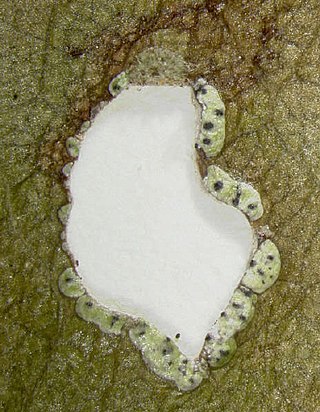
Strigula is a genus of lichen-forming fungi in the family Strigulaceae. The genus was circumscribed in 1823 by English mycologist Elias Magnus Fries.
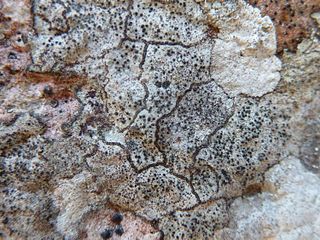
Parabagliettoa is a genus of crustose lichens in the family Verrucariaceae. It has 3 species. The genus was circumscribed in 2009 by Cécile Gueidan and Claude Roux, with Parabagliettoa dufourii assigned as the type species.
Heteroplacidium zamenhofianum is a species of lichenicolous (lichen-eating) lichen in the family Verrucariaceae. As a juvenile, it is parasitic on some members of the lichen genus Staurothele, but later becomes independent and develops a brown, crustose thallus. Characteristic features of the lichen include its dark brown, somewhat squamulous thallus and relatively small ascospores. It is widely distributed in Europe and North America.

Verruculopsis is a genus of saxicolous (rock-dwelling), crustose lichens in the family Verrucariaceae. It was circumscribed in 2007 by Cécile Gueidan, Pere Navarro-Rosinés, and Claude Roux, with Verruculopsis poeltiana assigned as the type species.
Claude Roux is a French lichenologist, mycologist and Esperantist. He has co-authored books about the identification of lichens written in Esperanto.
Agonimia tenuiloba is a species of corticolous (bark-dwelling) lichen in the family Verrucariaceae. Found in Brazil, it was formally described as a new species in 2013 by lichenologists André Aptroot and Marcela Cáceres. The type specimen was collected by the authors in the Estação Ecológica de Cuniã (Rondônia), where it was found growing on smooth tree bark in a rainforest. The lichen thallus comprises tiny, green, fan-shaped (flabellate) lobes and spherical goniocysts. Its ascomata are in the form of perithecia that are 0.3–0.4 mm wide and grey in colour due to a thin thalline cover. Its ascospores typically measure 30–50 by 20–35 μm. The European species Agonimia flabelliformis is similar in morphology, but it has shorter and narrower ascospores.
Swinscowia is a genus of lichen-forming fungi in the family Strigulaceae. It has 34 species. Swinscowia was proposed in 2020 by lichenologists Shu-Hua Jiang, Robert Lücking, and Emmanuël Sérusiaux to contain non-foliicolous species that were isolated from bark and rocks. Swinscowia jamesii, a species that was originally described in genus Geisleria, and later transferred to Strigula, is the type species of the genus. The genus name honours British lichenologist Dougal Swinscow, who originally described the type species in 1967.











